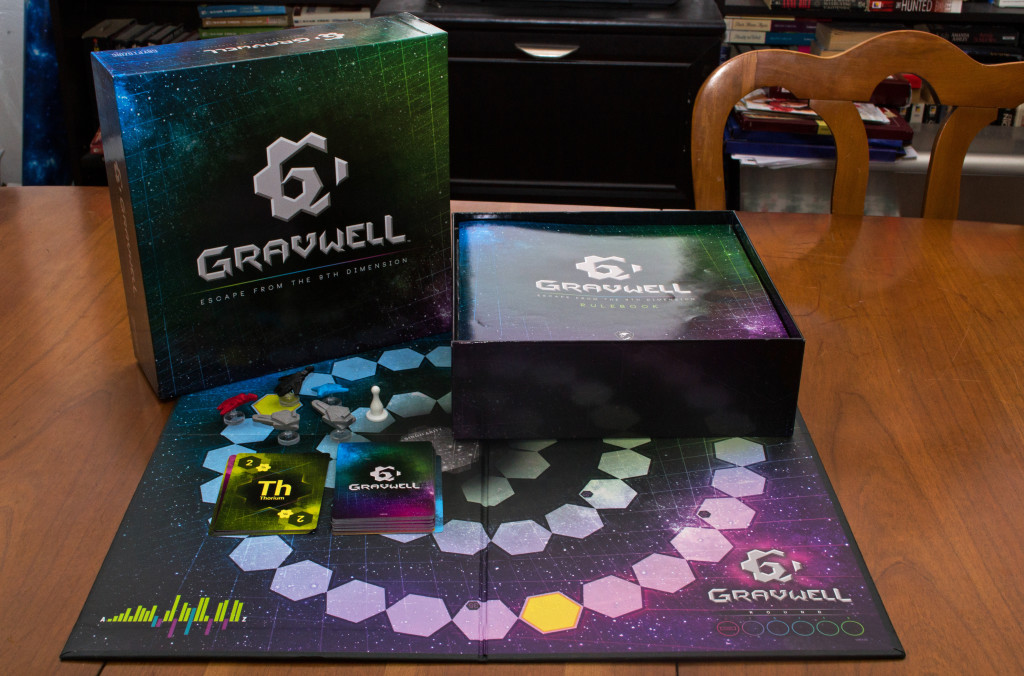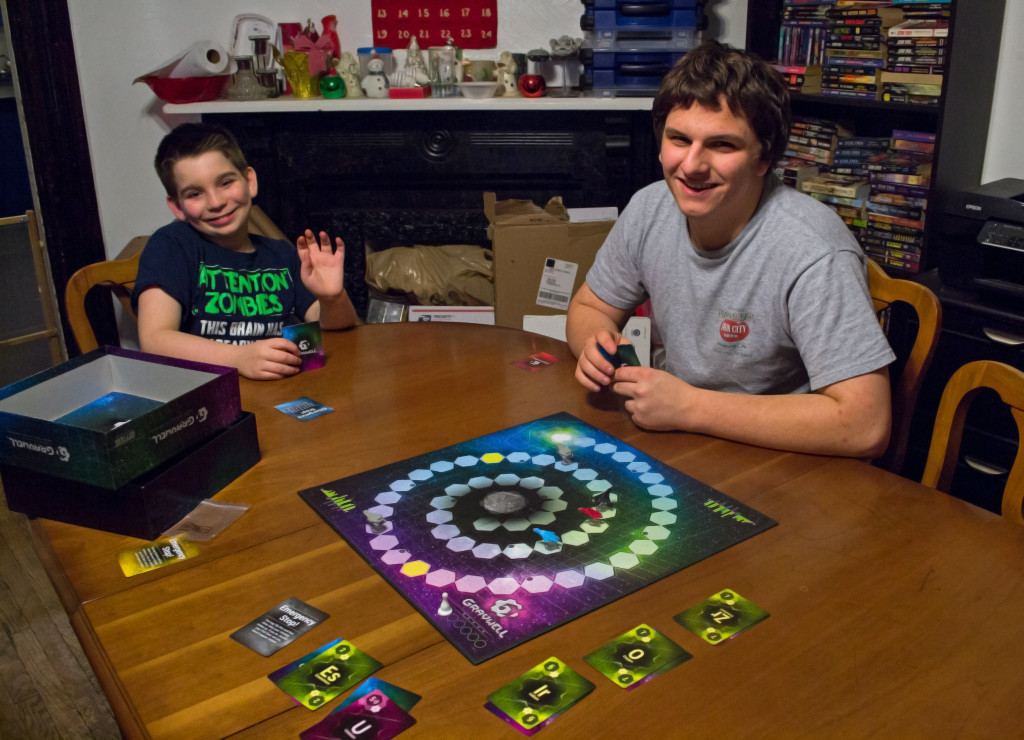You and a few fellow spaceships have just been sucked through a black hole and miraculously, you’ve all survived. Before you can catch your bearings, you realize that you’ve entered a different dimension and your fuel supplies are dwindling. There’s a warp gate nearby that’ll take you home, though the laws of physics seem to be different here. Rather than simply going forwards or backwards with the appropriate thrust, you find that any sort of movement will automatically pull you towards the closest object. Now you’ll have to plan your thrusts and tactically outmaneuver your opponents as they attempt to pull ahead of you and back home. Sadly, only one of you will make it. Will YOU be the one to escape from the ninth dimension?
Components
Board – The board consists of one spiral path, leading from the black hole in the center toward the warp gate situated on the outer edge. Two derelict spaceships (colored gray) are seeded in between. The round tracking pawn, as you may have guessed, keeps track of how many rounds have gone by.
Spaceships – There are four spaceships, one of each player color.
Cards – There are fuel cards (which allow players to move) and emergency stop cards (which allow players to prevent themselves from moving).
Setup & Gameplay
Each player will choose a spaceship, place it on the singularity (at the center of the board), and receive an emergency stop card of their color. The round tracker pawn is placed on the start space and either one or two derelict ships are seeded onto their yellow spaces, based on how many people are playing the game.
The game is played over a series of rounds. A typical round plays out as follows:
1. Preparing the Draft Pool: Shuffle the fuel cards and deal so many face down equal to the number of players times three. Then, deal a face-up card on top of each face-down card creating stacks of two…one card you can see and one card you can’t see. Any unused cards are put aside for this round.
2. Draft: Starting from the player furthest from the gate, they’ll choose a stack of two cards and take them. Players continue to draft until each player has six cards in front of them, which they’ll put into their hand. For the first round, draft order goes from youngest to oldest.
3. Movement Phase: Movement will occur six times during this phase. Each player will choose a card, place it face down in front of them, and reveal them all at once. They are resolved in alphabetic order (each card has an element listed on it). Once all ships have been moved, the process will repeat five more times until no one has any cards left in their hands. Players may only use their emergency stop card once per round.
Yellow cards act as standard movement in which the player will travel toward the closest ship, purple cards act as repulsors that push the player’s ship away from the closest ship, and teal cards act as tractor beams that pull all ships toward them (including derelicts).
Players continue playing out rounds until someone reaches the gate, in which case they win the game. If the round marker is on six already and a new round is called for, the game automatically ends in which case the closest player to the gate wins.
Editor’s Note: The above doesn’t cover all of the rules found in the manual, but should give you an idea as to how the game is played.
The Review
“Gravwell”, at its heart, is a drafting game that encourages players to pay attention to what’s going on at all times. For example, if you see your opponent drafting a lot of fuel cards that list an element that begins with a letter towards the end of the alphabet, there’s a good chance that most of your plays will happen first. You can then take this into account as you pick your cards. As such, the benefit of moving first and being able to count cards is probably the biggest advantage one can have in “Gravwell”. I admit that my memory is getting crappier and crappier the older I get, so I tend to play my cards based on what’s currently in front of me. On the plus side, each player gets a face-down card in addition to a face-up card during the drafting process, meaning that card counting fiends with eidetic memories won’t totally dominate their competition.
I did take issue with the price, which I’ve seen be anywhere from $30-$35. While the game is indeed a lot of fun to play, the number of components inside the box are incredibly sparse. Six ships (two are derelicts), a small deck of cards, and a board…that’s it. “Power Grid” and “Stone Age” come with almost ten times that amount and cost roughly the same price. The components themselves, while colorful, are nothing spectacular. Perhaps if the ship models were both solid & sleek-looking and the cards thicker & more durable, it might justify that kind of price…alas, they aren’t and therefore it doesn’t. In effect, you’re paying for the “idea” of the game and quite honestly, $20-$25 would have been a bit more realistic. As a side note, my copy was missing the yellow ship…I submitted a ticket, but the jury is still out on how quickly they’ll respond (if at all).
All in all, “Gravwell” does more right than it does wrong by keeping players engaged from start to finish. Who would I recommend this game to? That depends. I have a feeling this game might be frustrating for those who are used to being perfectionists in the games they play. Despite your best intentions, you’ll sometimes find yourself moving backward with no emergency stop card available to help you. Those who accept this as inevitable and instead think about how to minimize the backward movement will be much better off, I think. By that same token, children who frustrate and upset easily over setbacks may not do well here…in that case I’d recommend parental supervision. Speaking of children, I think the minimum age should be 8 or 10 plus, not 15 plus. With that said, if you can find this game for cheaper than $30 or if money simply isn’t a problem for you, then “Gravwell” is an easy recommend.
Final Verdict: 7/10
—


